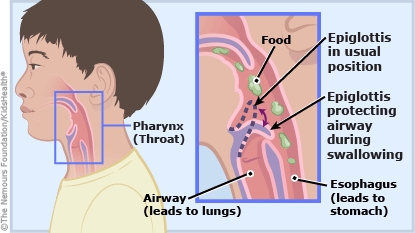Pharyngeal dysphagia is when a problem with a passageway in the throat (the pharynx) causes trouble swallowing. This may be due to a problem with the throat's structure or with the muscles or nerves that help control swallowing.
The pharynx leads to the esophagus (a tube that carries food down to the stomach) and to the beginning of the airway to the lungs. When we swallow, a flap of tissue (the epiglottis) normally covers the opening to the airway. This keeps food and drink from getting into the airway and lungs. Normally, the food and drink are then pushed down to the esophagus.
In pharyngeal dysphagia (fair-en-JEE-ul diss-FAY-jee-uh), kids have trouble swallowing. This can cause food or drink to get into the airway when they swallow. If this happens, it can make them cough, gag, become irritable or congested, or have watery eyes. If food or drink gets into the lungs, it can lead to pneumonia or breathing problems.
Dysphagia can be mild or more severe. Treatment varies depending on the symptoms and what's causing the swallowing trouble. It may include changing the way a child is fed or changing the texture of food to make it easier to swallow. It also may include feeding therapy with a speech therapist or occupational therapist.



Your child:

Your child:

What causes pharyngeal dysphagia? Many kids who have pharyngeal dysphagia are born with it, but some develop it later. Pharyngeal dysphagia can happen from: